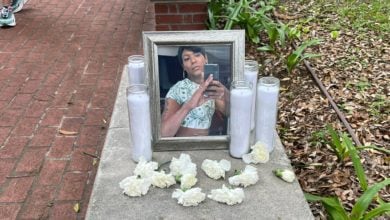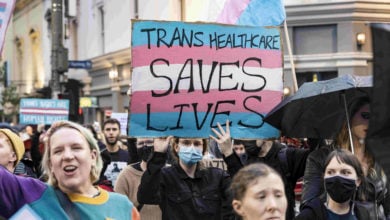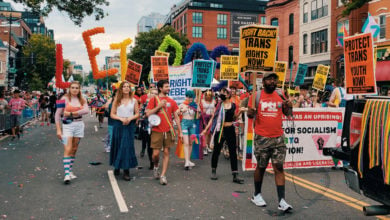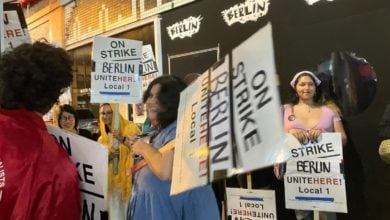The particular struggles of the lesbian, gay, bisexual and transgender community are not confined to marriage equality, although this battle receives the bulk of the attention of the corporate media. The fight for legal equality is of course critical, but other forms of LGBT oppression, especially those confronted by the day-to-day social and economic struggles of LGBT youth, poor and working people and people of color, are often overlooked.
Homelessness among LGBT youth
LGBT youth often experience harassment, violence and social ostracism in school, at home and in society at large, leading them to become homeless. Twenty percent of homeless youth in the United States identify as LGBT, compared to only 10 percent in the general population. A 2006 survey by the National Gay and Lesbian Task Force reported that one in four LGBT youth who come out to their parents are forced out of the home.
According to the National Coalition for the Homeless, many homeless LGBT people have trouble finding shelters that accept them, especially transgender people who are sometimes categorized as a gender they don’t identify with. Verbal, physical, and sexual abuse of homeless LGBT people in the shelter system is common. Around three out of every five LGBT homeless young people have been sexually victimized according to the National Coalition for the Homeless.
Stripped of basic support from their families and communities, with no governmental support to turn to, the education, health, and housing needs of LGBT youth frequently go unmet.
LGBT people experience police harassment, violence, and depression, manifesting in severe social isolation, as well as higher rates of suicide and substance abuse. These problems are particularly acute in areas of the country where there are fewer established LGBT communities and organizations, but is not confined to them.
Unemployment and job discrimination
These high rates of homelessness among LGBT persons are directly related to employment discrimination and economic exploitation more generally. The inability to access benefits offered to married couples is an additional economic burden. A 2009 Williams Institute report found that “[a]fter controlling for other factors, same-sex couples are significantly more likely to be poor than heterosexual couples.” In all sectors of the population suffering from disproportionate economic oppression—women, African Americans, Latinos, the elderly, residents of rural areas, and so on—the situation is even more severe for LGBT couples.
In 29 states, it is legal to fire someone on the basis of their sexual orientation. In 34 states, it is legal to fire someone for being transgender. (www.hrc.org) Such employment discrimination is routine. Even where such discrimination is illegal, in reality owners in the capitalist system have near dictatorial control over the hiring and firing process, and can conjure up any excuse to cover for discrimination.
A 2009 Transgender Law Center report found that transgender Californians are twice as likely to be below the federal poverty line than the general population. One in five respondents reported being homeless since first identifying as transgender.
The system’s sexist employment and wage patterns result in women working generally lower-paying jobs and, when doing comparable work, being paid only 77 cents for every dollar a man makes. Thus, while men in same-sex couples have roughly the same poverty rates as heterosexual men (13 percent), lesbian women are significantly more likely to be poor than heterosexual women. The gap is particularly striking among elderly lesbian couples.
LGBT people of color face great challenges, combating multiple forms of oppression and discrimination that have a direct impact on their daily lives and ability to earn a livelihood. The poverty rate among Black same-sex couples is three times higher than their white counterparts.
LGBT persons commonly face barriers to competent health care—including cost, lack of sensitivity and trust with medical professionals. These problems, too, are found to be more acute among LGBT people of color. (“All of the above: LGBT People of Color Report” by National Coalition for LGBT Health)
Fighting back
The fight for full LGBT equality includes the fight for education, jobs, housing and health care, basic needs that the capitalist system, at the service of the 0.1 percent, consistently neglects. It includes a determined opposition to the police who harass and brutalize LGBT youth. It includes an outspoken struggle against the homophobia and sexism promoted in the capitalist education system and in popular culture.
The Party for Socialism and Liberation participates fully in these struggles for LGBT equality, and explains that the capitalist system itself sustains each of these forms of oppression. This oppression of LGBT people is not an accident, nor is it solely the result of individual attitudes and homophobic biases. The privileging of the patriarchal family structure, which entails the domination of men over women and the construction of rigid sex roles, emerged alongside private property in the first class societies.
Rather than a social system based on private profit and property, we fight for a socialist society, in which every individual’s basic needs are guaranteed, discrimination is banned in fact (and not just on paper), and the values of the patriarchal family are undone so this sexist, homophobic culture can finally be defeated.






